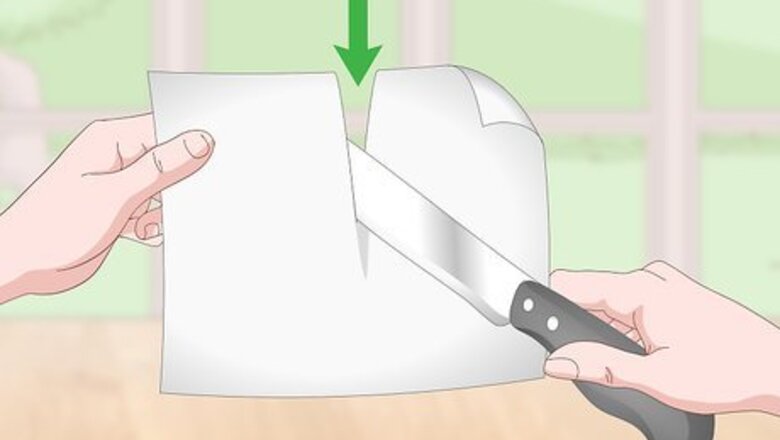
views
Sharpening a Dull Knife on a Manual Sharpener
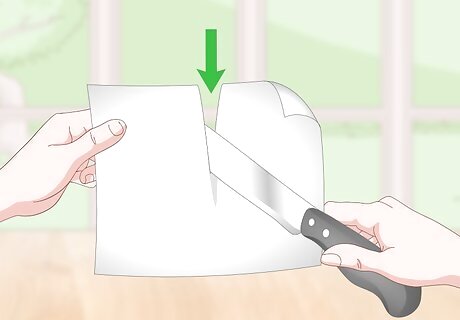
Test your knife by running it through a piece of paper. You may already know that your knife is dull, but if you aren’t sure, fold a piece of newspaper in half (or just use a single sheet of computer paper), hold it up in the air, and bring your knife down to cut through it. If your knife doesn’t slice through the paper, it’s time to sharpen it. The knife should continuously cut through the paper without stopping if it is sharp and in good shape.
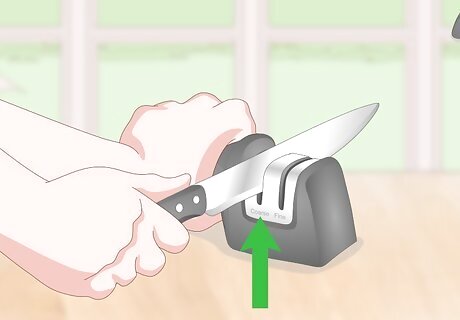
Use the “coarse” setting for very blunt knives that need to be reshaped. Most manual sharpeners have at least 2 settings: 1 labeled “coarse,” and 1 labeled “fine.” The coarse setting will actually remove steel from the blade to resharpen the edge, while the fine setting is used for everyday knife maintenance. These settings are the same on electrical sharpeners, though an electric sharpener may have an additional slot between “coarse” and “fine.”
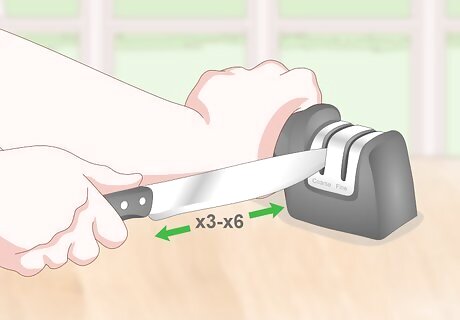
Pull the blade through from its base to its tip 3 to 6 times. Insert the blade into the manual sharpener at the base, which is where the blade meets the handle. Use gentle force, pushing the blade down as you pull it through the slot, toward your body. Repeat this action 3 to 6 times, 3 for a mildly-dull blade, or more for a severely-dull blade. This action resets the blade, restoring it to its original sharpness. Use enough force when you pull the blade through that you hear an audible grinding sound. If you’re using an electric sharpener, you won’t need to press down—the whirring mechanisms will take care of everything for you.
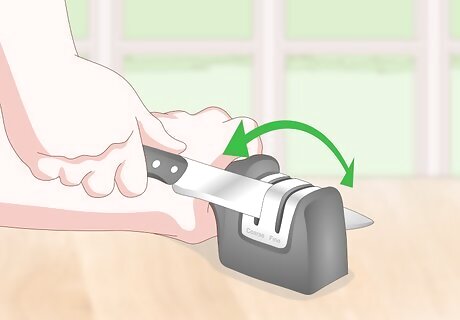
Move the blade so you’re following its contour as you pull it through. Each time you bring the knife through the sharpener, you won’t just pull it straight through. Instead, follow the curve of the knife so that the handle comes up and is higher at the end than it was at the beginning. This way, the entirety of the blade will get sharpened. If you’re pressing down, you’ll be able to tell by the sound and feel that you’re moving the blade the right way. If you no longer hear the grinding noise or feel the resistance of the blade, you probably aren’t following the contour closely enough.
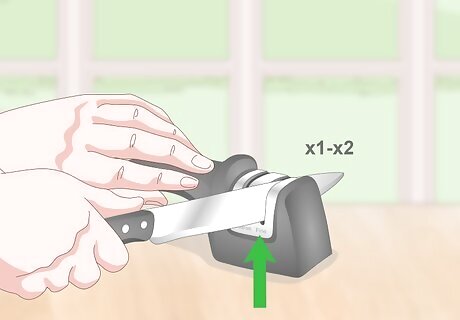
Run the blade through the fine setting 1 to 2 times to finish the process. After you’ve finished pulling the blade through the “coarse” setting, you need to give it a few finishing touches to refine its edge. You don’t need to use as much force with the “fine” setting, and the grinding sound won’t be nearly as loud as it was in the “coarse” setting. If your sharpener has more than one setting, pass the knife through each in-between setting 1 to 2 times, making sure that you end at the “fine” setting. These additional settings are just gradations of grinding and help fine-tune your knife even more.
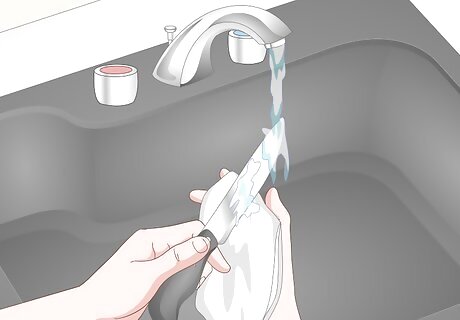
Rinse the knife off and dry it with a lint-free towel. Use warm, soapy water to rinse away any lingering steel remnants before using your knife again. Feel free to use a sponge or dishtowel to give the knife a quick wipe down. Dry the knife off completely to prevent it from rusting, and return it to its knife block or similar storage space. Avoid running your knives through the dishwasher. They can get banged up or damaged by other items.
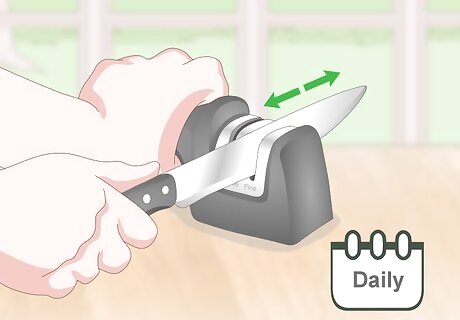
Maintain the knife by running it through the “fine” setting daily. The general rule of thumb is to pull your knife through the fine setting once for every 2 hours of use. Depending on how often you cook, you may not need to do this every day, but keep it in mind as a helpful way to keep your knife sharp. If you do a daily or semi-weekly pass through the manual sharpener, chances are you won’t need to do much more to keep your knives sharp.
Using Different Sharpening Methods
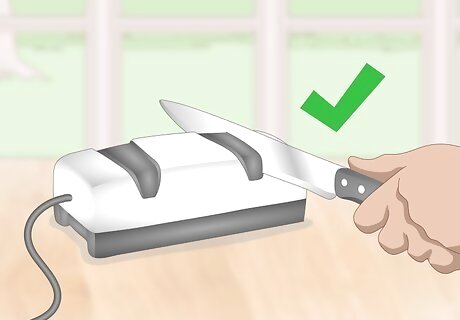
Invest in an electric sharpener if you cook often with expensive knives. Electric sharpeners themselves are more expensive than manual sharpeners, running about $40 to $100, depending on the brand you get. They’re more intuitive, though, and are really easy to use as they will just pull the blade through for you. It takes less time and effort to sharpen your knives than the other manual methods require. Make sure to do your research before ordering your electric sharpener. Some brands are meant for specific kinds of knives, and some include extra features, like a lifetime warranty.
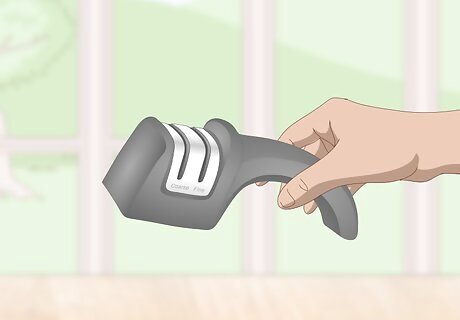
Buy a pull-through or handheld sharpener for a nice at-home option. This is a really nice choice for your everyday home cook who doesn’t spend more than an hour or 2 in the kitchen every day. They’re smaller than the electric versions, making them easier to store, and they’re fantastic to use for daily touchups or for grinding a dull blade back to sharpness. They cost anywhere from $10 to $60, depending on the brand you choose. There’s something to be said for the feeling of manually sharpening your own knife, too. Lots of cooks enjoy the physicality of taking care of their knives and you do get more control over your movements with a manual sharpener than you would with an electric sharpener.
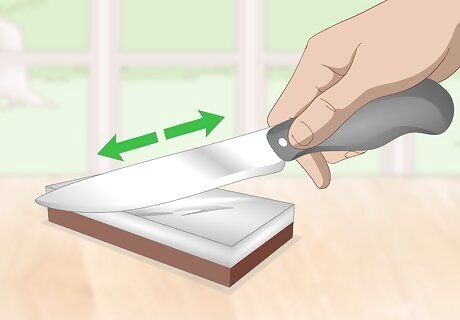
Opt for a whetstone for a gentle, temperature-controlled sharpener. Whetstones are generally just a small block of material that you’ll run your knife down to sharpen its blade. Always soak it in water for at least 5 to 10 minutes before you use it. Hold the knife at a 22-degree angle and slide it forward down the whetstone, with the blade touching the stone. Repeat the movement 5 to 10 times to sharpen your knife. The cold-water soak keeps your knife from overheating as it’s being sharpened. If a knife gets too hot, it’s chemistry can change and the blade can become brittle and warped. Do double-check the instructions before wetting your whetstone. While the majority of them do need to be soaked beforehand, there are a few brands and types of stones that aren’t meant to get wet.
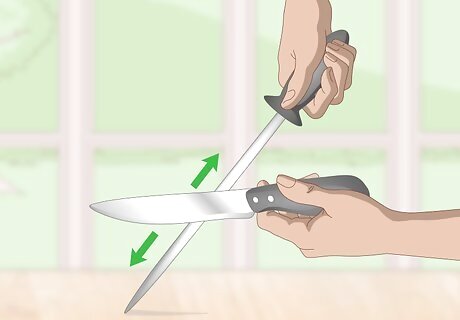
Use a honing rod to quickly realign the edges of the blade. A honing rod is also often called a sharpening steel, and they often come along with a block-knife set. Honing doesn’t actually remove any steel from the knife and doesn’t technically sharpen it, but it does push out-of-line edges back into place, which in turn makes your cuts sharper and more precise. It doesn’t require much pressure, and it’s something you can use on a daily basis to keep your blades sharp. Don’t use a honing rod in lieu of sharpening your knives with an alternative method from time to time. It can bend the edge over time, making it hazardous to use.
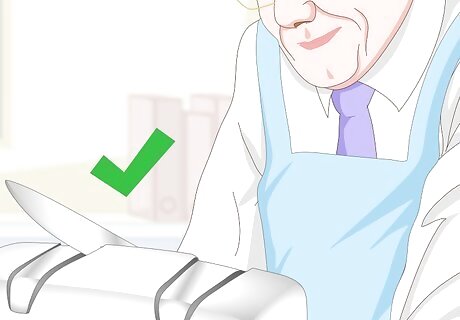
Take your knives to a professional if you can’t do it yourself at home. It costs about $1.50 to $2.25 per inch to have your knives sharpened by a professional. Some companies allow you to ship your knives to them if you don’t live nearby (you’ll need to pay the shipping costs, though). Check out your warranty! Some knife brands offer free sharpening for life, so that might be something you could take advantage of, too.











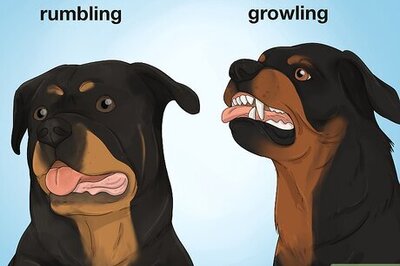





Comments
0 comment